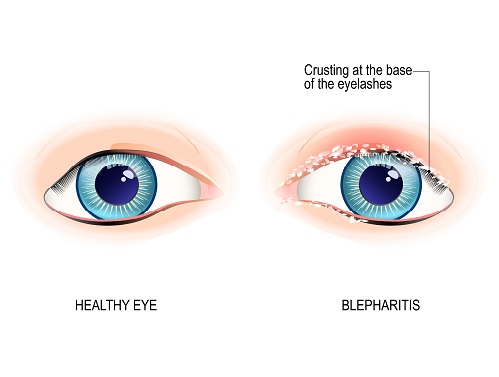Blepharitis is a common disorder. It consists of an inflammation of the eyelids caused by bacterial (dandruff like flakes) and clogging of the tiny oil glands (meibomian glands) near the base of the eyelids that can make your eyelids swollen, red, and/or feel like they are burning.
There are two classifications of blepharitis:
- Anterior blepharitis
- occurs at the outside front edge of the eyelid where the eyelashes attach
- the bacteria (staphylococcal blepharitis) that causes anterior blepharitis is commonly found on the face and eyelids. If these bacteria become excessive, or the lid area reacts poorly to their presence, an infection may occur. A less common cause of anterior blepharitis may include allergies or a mite infestation of the eyelashes.
- Posterior blepharitis
- affects the inner edge of the eyelid that touches the eyeball
- occurs when the glands of the eyelids irregularly produce oil creating a favorable environment for bacterial growth. May be associated with rosacea, acne and scalp dandruff.
Blepharitis Symptoms
- itching
- grittiness
- photophobia (light sensitivity)
- eyelid crusting,
- red, swollen eyes
- dryness
Treatment for Blepharitis
Skin and Eyelid Hygiene – Keeping your hair, skin and eyelids clean will help keep your blepharitis under control
Warm Compresses – Using a clean washcloth, wet it with warm water and wring it out as much as you can until it is almost dry. Place the washcloth over your closed eye for at least one minute to help loosen the flakes sticking to your eyelashes – a microwavable mask is useful as well.
Antibiotics – your ophthalmologist may prescribe an antibiotic ointment for your eyes.
Eyelid Scrubs – Soak a cotton swab (Q-tip) applicator, lint-free pad or clean washcloth in warm water. Then gently scrub the base of your eyelashes for about 15 seconds with diluted baby shampoo. Hypochlorous acid, OCuSoft or tea tree oil scrubs may be helpful.
Eye Drops – Antibiotic steroid eye drops or artificial tears may reduce the swelling, redness, and dry eye but only for a limited time.
Although there is no cure for blepharitis, IPL also known as intense pulse light is an exciting treatment modality for blepharitis cases with associated dry eye.
The key to treating most blepharitis is keeping the eyelids clean and free of crust. This can be accomplished using the above treatments. If you are experiencing any of the symptoms of blepharitis, make an appointment to see your eye doctor today.







